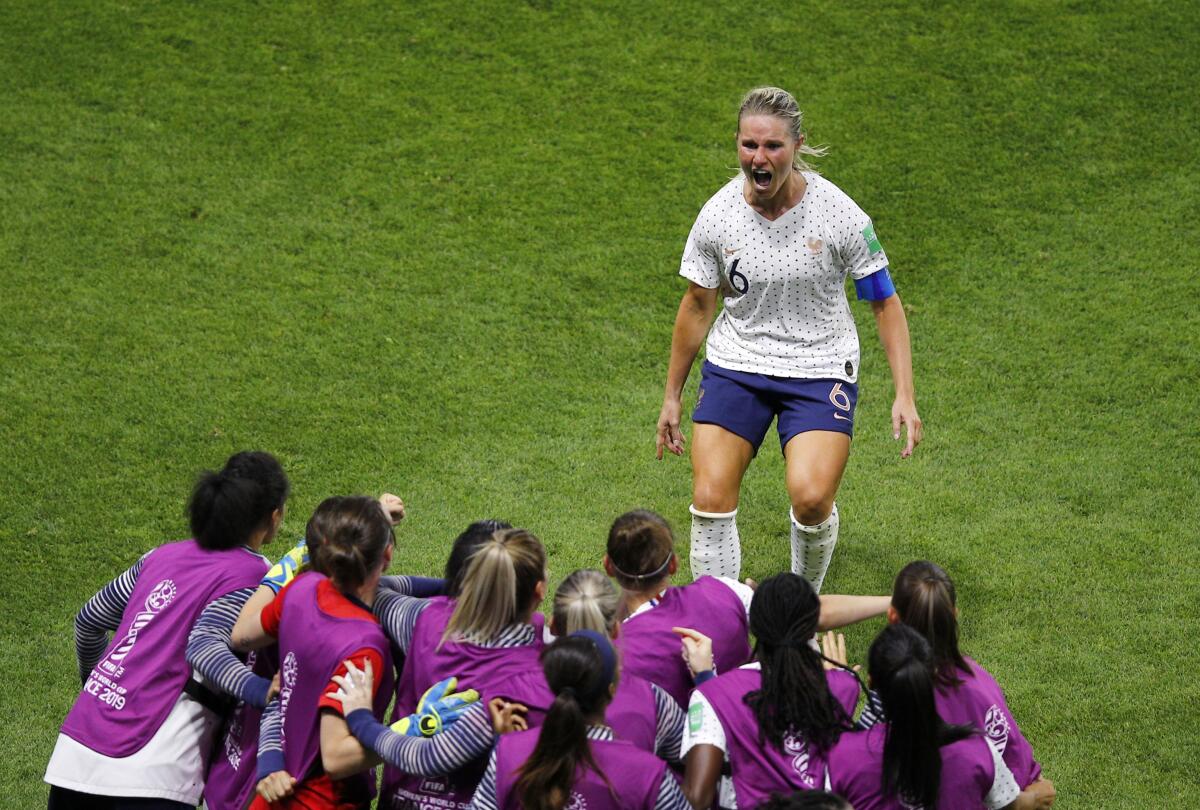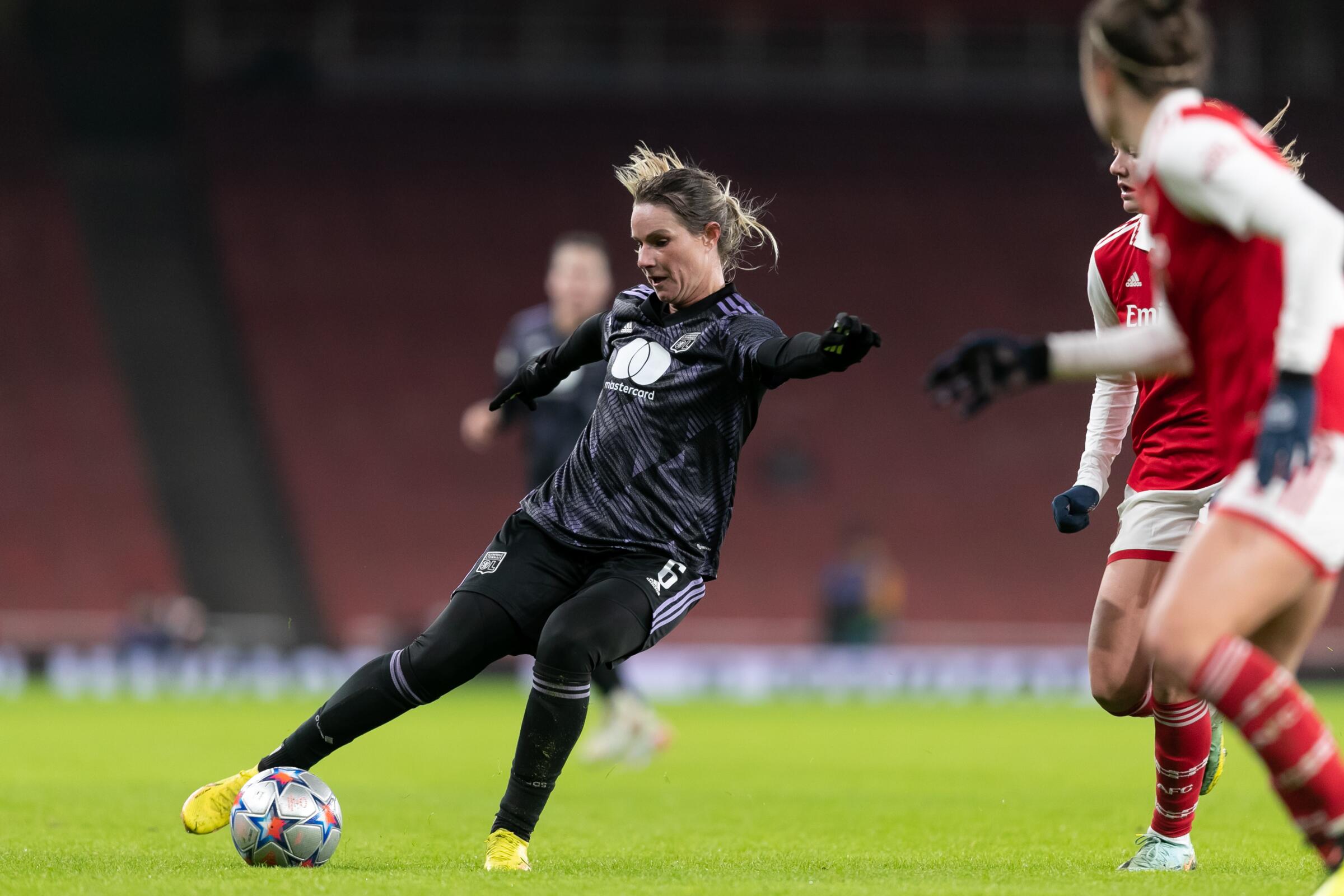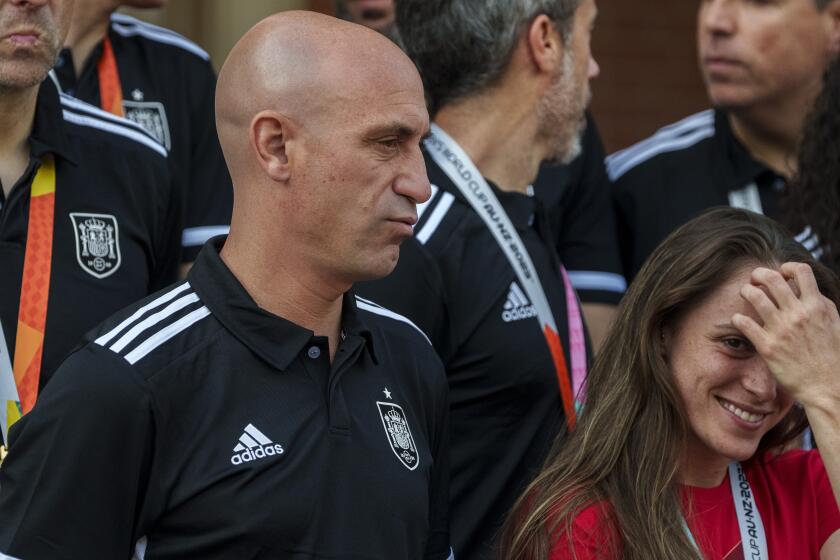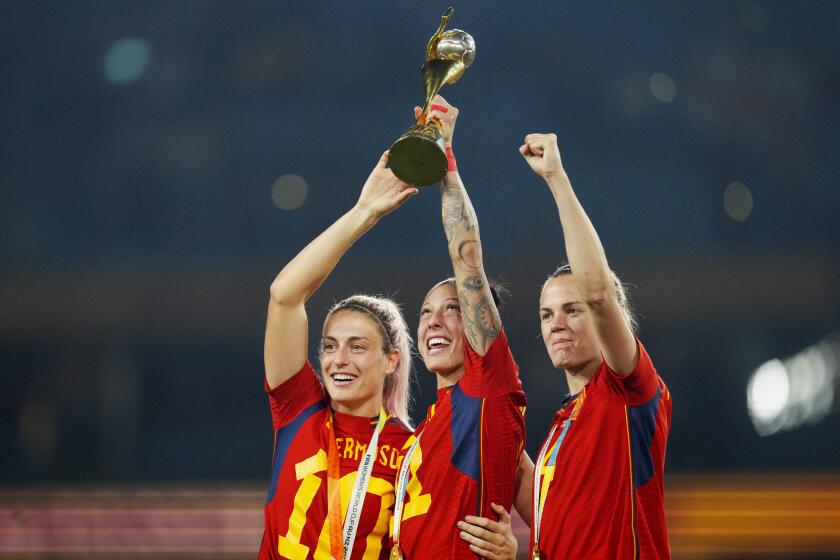Kevin Baxter writes about soccer and hockey for the Los Angeles Times. He has covered seven World Cups, five Olympic Games, six World Series and a Super Bowl and has contributed to three Pulitzer Prize-winning series at The Times and Miami Herald. An essay he wrote in fifth grade was voted best in the class. He has a cool dog.
- Share via
1
Amandine Henry is a winner. Don’t take my word for it, just take a look at her resume.
Thirteen French first-division titles and seven Champions League crowns with Lyon. A league title and NWSL Shield in the U.S. with Portland. All together, the former French national team captain has collected 32 trophies for club and country in a 19-year professional career. Only a handful of players, of either gender, have won more.
So it wasn’t the pursuit of hardware that led Henry to Los Angeles, where she joined an Angel City team still looking for its first trophy two seasons into its existence.
“It’s a new challenge because Los Angeles is a new team,” she said. “I think it’s the best moment to have a new challenge and I want to continue to progress myself.”
FIFA suspended Spanish soccer President Luis Rubiales for 90 days while it investigates his conduct, which included kissing a player without her consent.
Angel City is likely thinking something else. Henry, the team knows, has gone a full year without collecting a trophy just once since 2008 … and she’s empty-handed so far in 2023.
“To have a player of her caliber come into the club is massive, on and off the field,” said interim manager Becki Tweed, whose team is unbeaten in its last nine games in all competition, leaving it three points out of a playoff berth with five games to play. “What better role model than her to be surrounded by. Someone who’s played globally. Who’s played in the Olympics, World Cups and been outside the U.S. for portions of her career as well.”
Henry’s move from Lyon to L.A. is curious nonetheless since it comes at a time when many top players are heading the other way. Four years ago, more than one in 10 women’s World Cup players came from NWSL. But this summer, England’s Women’s Super League and Spain’s Liga F — a league its own federation didn’t recognize as professional until 2020 — surged past the U.S. league, combining to supply nearly a quarter of the 736 players in the tournament.
Not surprisingly, Spain and England made it to the final with rosters made up almost entirely of players from their domestic leagues.
The recent exodus from the NWSL has seen Sam Kerr, the league’s all-time leading scorer, bolt for Chelsea of the WSL. England’s Rachel Daly, most valuable player of the 2020 NWSL Challenge Cup, plays for Aston Villa; former Houston Dash teammates Lydia Williams and Clare Polkinghorne, both from Australia, play for clubs in England and Sweden, respectively; while Ellie Carpenter, once the youngest player in NWSL history, is with Lyon, Henry’s former club in France.
Investment in the game has finally created parity in the Women’s World Cup. Hopefully FIFA boss Gianni Infantino no longer has to be condescending.
Even Lindsey Horan, captain of the U.S. national team, is gone, leaving the Portland Thorns to sign a three-year deal with Lyon.
Tweed said the competition with the foreign leagues to sign the best players is welcome because it will make the game better.
“If every league can continue to push forward, other leagues have to grow. It’s almost a game of ‘you do this, we’ll do it better,’” she said. “The more we can support each other but compete against each other, the better it makes the sport.”
Speaking of competition, while the European leagues may be collecting elite talent, the NWSL remains a far more exciting and competitive league. The average gap between first and last place in the top three European leagues last season was 55 points, more than double that in the NWSL, where eight of the 12 teams entered the final day of the regular season with a chance at the title thanks to the league’s playoff format.
Average attendance in the U.S. league was double the European leagues as well.
“As much as the game’s grown in Europe, there’s still a disparity from top to bottom,” Tweed said. “When you look around the NWSL, there’s parity on and off the field, but also in facilities and stadiums and crowds. For anybody that’s in a latter stage of their career and been in the NWSL and been in Europe, to crave that feeling every week is probably something that’s exciting.”
That certainly describes Henry, a defensive midfielder who admits she’s far closer to the finish line than to the start. The longtime French captain was left off the roster for last year’s Euros in a dispute with then-coach Corinne Diacre and missed this summer’s World Cup with an injury. She signed a 1½-year deal with Angel City in June, two months after a sprained left knee ended her final season with Lyon. She was on the bench for Angel City’s last two games but has yet to play for her new team.

(Francois Mori / Associated Press)
“I’m almost 34 years old and I want to prepare my progression,” she said. “I want to enjoy the end of my career and the new challenge. For me it’s more exciting, to continue to progress.”
“It’s completely different because the style here is different,” she continued of the NWSL. “It’s more athletic, more physical, more direct.”
Henry isn’t new to the NWSL, having played 30 games over two seasons in Portland, winning a league shield in 2016 and a regular-season title in 2017. Her return, she hopes, will help prepare her for a post-playing career as a general manager or sporting director.
Winning another trophy with Angel City, extending her title streak, would also make that resume better.
“I hope to win a new title, but for the moment [the goal] is qualification for the playoffs,” she said. “And to learn English.”
⚽ You have read the latest installment of On Soccer with Kevin Baxter. The weekly column takes you behind the scenes and shines a spotlight on unique stories. Listen to Baxter on this week’s episode of the Corner of the Galaxy podcast.








